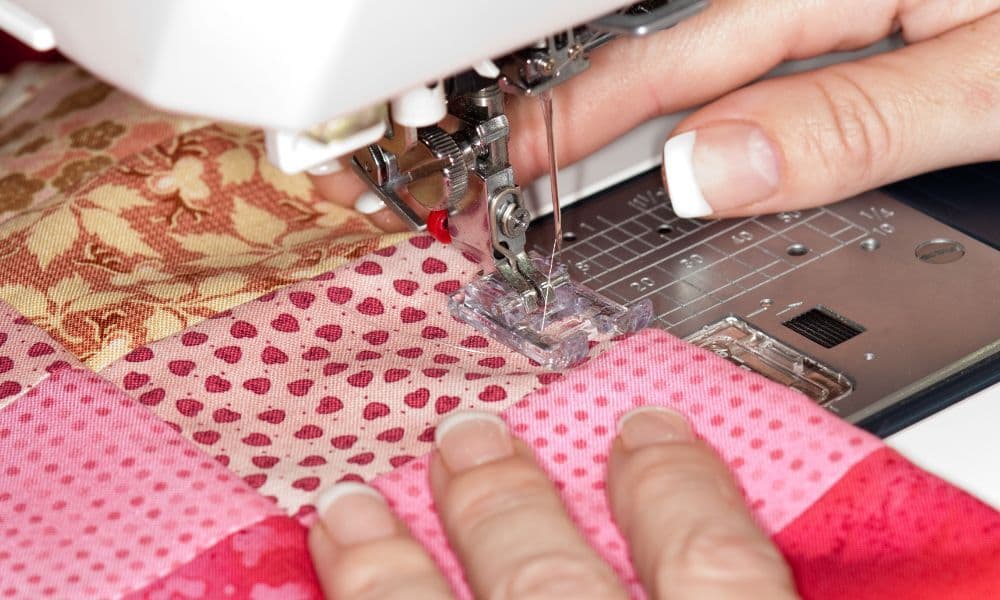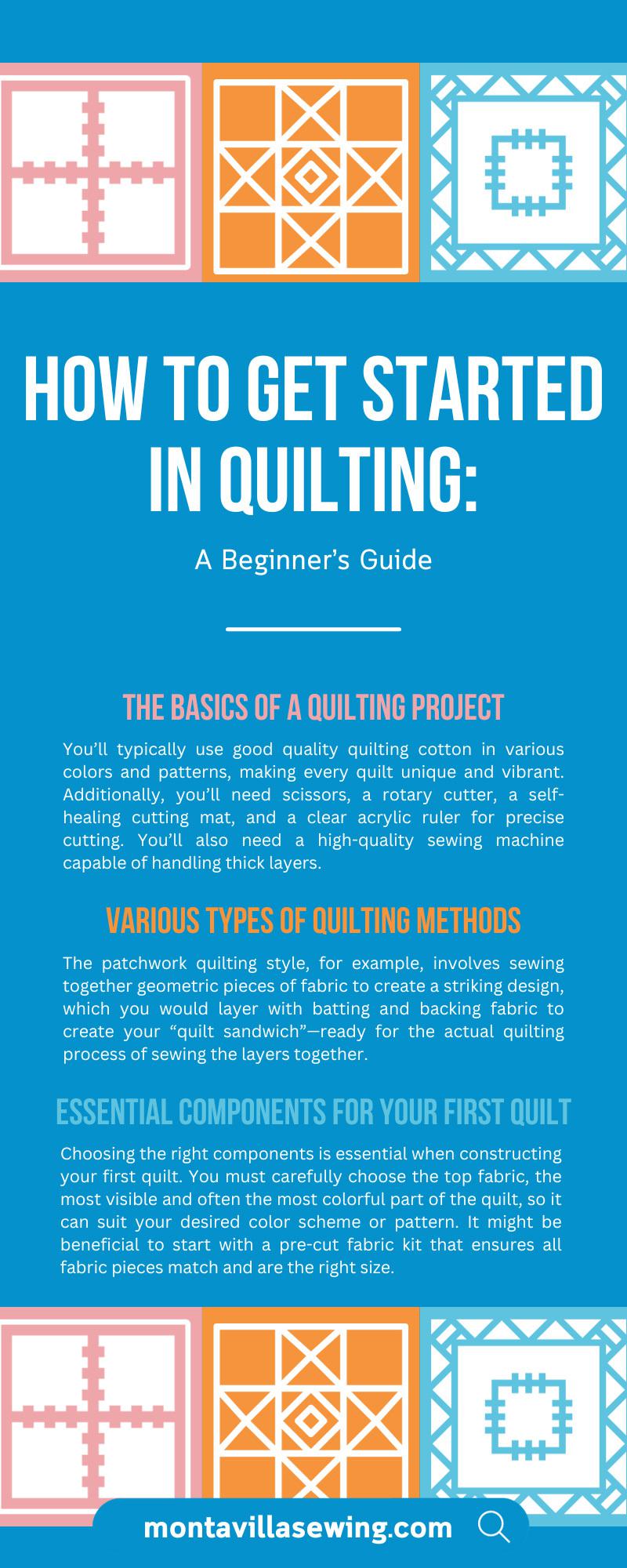Montavilla Sewing Blog

How To Get Started in Quilting: A Beginner’s Guide
January 8, 2024
Quilting is an art form steeped in history and tradition. It’s an enriching activity that allows you to express your creativity, create functional works of art, and connect with others who share the same passion.
Perhaps you’ve been captivated by the intricate designs on a quilt at a craft fair or have been gifted a quilt by a family member and felt an urge to try quilting. Our beginner’s guide on how to get started in quilting will set you on the path to creating your very first quilt.
The Basics of a Quilting Project
You’ll need to familiarize yourself with the essential materials and tools to successfully embark on your quilting journey. The heart and soul of every quilt is the fabric. You’ll typically use good quality quilting cotton in various colors and patterns, making every quilt unique and vibrant. Additionally, you’ll need scissors, a rotary cutter, a self-healing cutting mat, and a clear acrylic ruler for precise cutting. You’ll also need a high-quality sewing machine capable of handling thick layers.
Thread, pins, and needles will also become a part of your essential quilting toolkit. Techniques to master include precise cutting, piecing squares and triangles together, and understanding pattern layouts. As a beginner, focus on learning these tools and techniques step by step, practicing and refining your skills as you progress.
Various Types of Quilting Methods
Quilting isn’t a one-size-fits-all craft; it comes in several distinctive styles and methods, each with its unique charm, so you can choose one that resonates with you. The patchwork quilting style, for example, involves sewing together geometric pieces of fabric to create a striking design, which you would layer with batting and backing fabric to create your “quilt sandwich”—ready for the actual quilting process of sewing the layers together.
On the other hand, appliqué quilting involves sewing pieces of fabric onto a larger piece to create a picture or pattern. English paper piecing is another technique, perfect for creating intricate, symmetrical designs, where you stitch fabric together using paper templates.
Moreover, you can explore whole-cloth quilts, focusing more on elaborate quilting than pieced designs. As you delve deeper into the world of quilting, you may discover a style that captivates you or even decide to blend different techniques to create your unique quilting style.
Essential Components for Your First Quilt
Choosing the right components is essential when constructing your first quilt. You must carefully choose the top fabric, the most visible and often the most colorful part of the quilt, so it can suit your desired color scheme or pattern. It might be beneficial to start with a pre-cut fabric kit that ensures all fabric pieces match and are the right size.
The batting, sandwiched in the middle of your quilt, provides warmth. Various types of batting are available, such as cotton, wool, and polyester, each with unique properties—cotton is breathable, wool provides excellent warmth, and polyester is lightweight and affordable. Your selection should depend on your quilt’s intended use.
The backing fabric, which is the underside of the quilt, could be a solid color to showcase your quilting stitches or a print that coordinates with the front of your quilt. Finally, thread used for piecing and quilting should be strong and durable, typically 100% cotton or polyester or a strong blend of the two. Use a thread that matches or blends with your fabric (neutral gray or tan are good choices) to keep the focus on the fabric when piecing. Feel free to experiment with contrasting thread colors when quilting to highlight your stitches.
Practice Your Patchwork Piecing Skills
As you embark on your quilting adventure, mastering basic patchwork piecing skills with simple blocks like four-patch and half-square triangles is invaluable. Beginners often start with the humble four-patch block, a fundamental building block in quilting composed of four squares sewn together. It’s an excellent exercise in precision, as aligning the corners can be tricky, but with practice, you’ll be adept in no time. As you become proficient in creating these basic blocks, the intricate designs you can craft from such simple elements will amaze you.
Equally important is the half-square triangle, a versatile block comprising two right-angle triangles. This simple yet dynamic block can form many patterns depending on its orientation and color placement, sparking boundless creativity. You’re well on your way to creating your first quilt and experiencing the joy and satisfaction of this timeless craft!
Learn How To Use Basting Methods
You must ensure your quilt sandwich—the top layer, batting, and backing—stays firmly together before you start quilting. This critical step, known as “basting,” prevents the layers from shifting or puckering during quilting. Stitch basting, or hand basting, is a popular basting method. It requires you to sew long-running stitches through all the layers. This traditional method can be time-consuming but offers excellent control and is an efficient way to secure every part of your quilt sandwich. You can do this by hand basting or basting your quilt with your machine if it has the capability of an extra-large basting stitch.
A temporary alternative is spray adhesive, a quick and efficient way to baste your layers together. This method eliminates the need for pins or stitches, making it easy to adjust and reposition your layers. However, use a spray designed specifically for quilting to avoid damaging your fabric or sewing machine.
Instead of using stitches or adhesive spray, you can also use a method known as pin basting, which is a technique where you use one- to two-inch safety pins. This method involves spreading your quilt sandwich on a flat surface and inserting safety pins about a hand’s width apart throughout the quilt. The key to successful pin basting is ensuring you place the pins evenly and penetrate all three quilt layers.
Pin basting is an effective method that gives you the flexibility to adjust layers as needed, which can be especially helpful for those working on larger projects.
The method you choose largely depends on your preference, your quilt’s size, and the specific requirements of your quilting project. Explore different techniques to determine which suits your workflow best. Remember, a well-basted quilt is the foundation of a well-finished quilt.
Use a Quilt Design Board or Wall
A quilt design board or wall is a fantastic tool that can truly revolutionize your quilting process. Imagine having a large, visible canvas where you can lay out your patchwork pieces, observe the interplay of colors and patterns, and easily rearrange elements to experiment with different designs. This perspective can be invaluable in spotting any design inconsistencies or elements that don’t quite fit before you start sewing your pieces together.
Quilt design boards or walls can be as simple or as elaborate as you want. Some quilters use a large piece of batting or flannel that can hold fabric pieces through the material’s natural stickiness. Others opt for a corkboard covered with batting, which allows for pinning pieces if needed. Alternatively, you can purchase a commercially produced design wall that you can hang anywhere you have the space.
We hope our comprehensive beginner’s guide on how to get started in quilting inspires you to embark on your first quilting project! Visit Montavilla Sewing Centers today if you need tools or a little more guidance! We’re a sewing machine store that sells notions, fabrics, and high-quality sewing machines and offers classes that cater to every skill level. We can guarantee you’ll leave our store, either virtually or in person, feeling a little more confident in your sewing skills!
